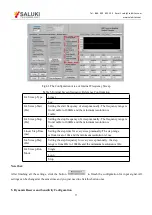
Tel: 886. 909 602 109 Email: [email protected]
www.salukitec.com
64
4.2.6 Save and Read Settings Commands
SSET i
The SSET i command saves the current setup in setting buffer i (1≤i≤4). The parameter i
selects S1 (i=1), S2 (i=2), S3 (i=3) or S4 (i=4). The setting buffers are retained when the
power is off.
RSET i
The RSET i command recalls the saved setup information from buffer i (1≤i≤5). After
executed the RSET i command, the internal parameters will be set as corresponding
parameter in the setting buffer i. The parameter i selects S1 (i=1), S2 (i=2), S3 (i=3), S4
(i=4) and Default (i=5).
4.2.7 Auto Set Commands
AGAN
The AGAN command performs the Auto Gain function. It is the same as pressing the [Auto
Gain] key. Auto Gain may take some time if the time constant is long.
ARSV
The ARSV command performs the Auto Reserve function. It is the same as pressing the
[Auto Reserve] key. Auto Reserve may take some time.
APHS
The APHS command performs the Auto Phase function. It is the same as pressing the
[Auto Phase] key.
The outputs will take some time to reach their new values. Do not send a new APHS
command without waiting the appropriate amount time. If the phase is unstable, then APHS
will do nothing.
Use PHAS? Command to query the new value of the phase shift and see if APHS changed
the phase shift.
ASCL
The ASCL command performs the Auto Scale function. It is the same as pressing the [Auto
Scale] key.
4.2.8 Data Store Commands
SRAT(?){i}
The SRAT command sets or queries the step time of data sampling. SRAT? command will
return the value of step time in sampling. The setting range of i is 1ms-100,000ms. The
minimum resolution is 1ms.
SLEN(?){i}
The SLEN? command sets or queries the length of data sampling. The maximum length is
16384.
SSLE(?)i{,j}
The SSLE i command sets or queries the chosen parameters in four buffers. The parameter
i must be set when sending this command. The parameter i selects <Buffer 1> (i=1),
<Buffer 2> (i=2), <Buffer 3> (i=3) or <Buffer 4> (i=4). The parameter j means the
recorded measurement value in buffers.
The parameter j selects the parameters as the following.
















































